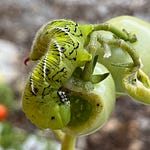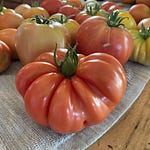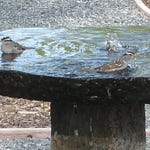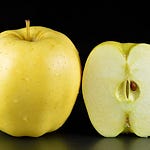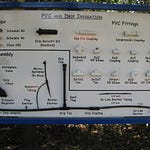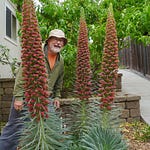Debbie Flower, America’s Favorite Retired College Horticulture Professor, brought up the subject of “Cation Exchange Capacity” back in Episode 193 of the Garden Basics with Farmer Fred podcast, while discussing the limited lifespan of bagged worm castings. That alone should pique your interest. Go ahead and listen to that segment or read the transcript. I’ll wait.

In the podcast in this newsletter, Debbie goes into depth about cation exchange capacity. If you were a high school chemistry class wizard, you’re excited to learn how the electronic charges in the soil aid and abet the feeding of plants. The rest of us need a bit more help (I took high school chemistry a couple of times. I still don’t get it.).
Here’s an almost easy to understand explanation of the chemistry going on beneath our feet. From Australia’s Katharine Brown (The University of Western Australia) and Jeremy Lemon (Department of Agriculture and Food, Western Australia), entitled, “Cations and Cation Exchange Capacity”. At the very least, you’ll learn about “meq”. Again, this is why this newsletter is entitled the way it is.
Cations and Cation Exchange Capacity
Key Points
Cation exchange capacity (CEC) is the total capacity of a soil to hold exchangeable cations.
CEC is an inherent soil characteristic and is difficult to alter significantly.
It influences the soil’s ability to hold onto essential nutrients and provides a buffer against soil acidification.
Soils with a higher clay fraction tend to have a higher CEC.
Organic matter has a very high CEC.
Sandy soils rely heavily on the high CEC of organic matter for the retention of nutrients in the topsoil.
Background
Cation exchange capacity (CEC) is a measure of the soil’s ability to hold positively charged ions. It is a very important soil property influencing soil structure stability, nutrient availability, soil pH and the soil’s reaction to fertilisers and other ameliorants (Hazleton and Murphy 2007).
What are exchangeable cations?
The clay mineral and organic matter components of soil have negatively charged sites on their surfaces which adsorb and hold positively charged ions (cations) by electrostatic force. This electrical charge is critical to the supply of nutrients to plants because many nutrients exist as cations (e.g. magnesium, potassium and calcium). In general terms, soils with large quantities of negative charge are more fertile because they retain more cations (McKenzie et al. 2004) however, productive crops and pastures can be grown on low CEC soils.
The main ions associated with CEC in soils are the exchangeable cations calcium (Ca2+), magnesium (Mg2+), sodium (Na+) and potassium (K+) (Rayment and Higginson 1992), and are generally referred to as the base cations. In most cases, summing the analysed base cations gives an adequate measure of CEC (‘CEC by bases’). However, as soils become more acidic these cations are replaced by H+, Al3+ and Mn2+, and common methods will produce CEC values much higher than what occurs in the field (McKenzie et al. 2004). This ‘exchange acidity’ needs to be included when summing the base cations and this measurement is referred to as effective CEC (ECEC).
Measuring CEC
Different laboratories use various methods to measure CEC, and can return contrasting results depending on the fraction of the soil measured. In Australia, some laboratories measure CEC directly and others calculate it as CEC by bases. Cation exchange capacity is commonly measured on the fine earth fraction (soil particles less than 2 mm in size). In gravelly soils the effective CEC of the soil as a whole is diluted, and if only the fine (clay) fraction is analysed, reported CEC values will be higher than actual field values.
Measuring CEC involves washing the soil to remove excess salts and using an ‘index ion’ to determine the total positive charge in relation to original soil mass. This involves bringing the soil to a predetermined pH before analysis. Methods, including pre-treatment, for measuring CEC and exchangeable cations are presented by Rengasamy and Churchman (1999) and described in detail by Rayment and Higginson (1992).
Units
CEC is conventionally expressed in meq/100 g (Rengasamy and Churchman 1999) which is numerically equal to centimoles of charge per kilogram of exchanger (cmol(+)/kg).
Management Implications
Soil type and CEC
The CEC of soils varies according the clay %, the type of clay, soil pH and amount of organic matter. Pure sand has a very low CEC, less than 2 meq/100 g, and the CEC of the sand and silt size fractions (2 µm/2 mm) of most soils is negligible. Claying sandy soils for managing water repellence increases the CEC of the surface layers by a small amount depending on type and amount of clay added. Typically CEC is increased by less than 1 meq/100 g.
The most commonly occurring clay in Western Australian soils, kaolinite, has a CEC of about 10 meq/100 g. Other clays such as illite and smectite have CECs ranging from 25 to 100 meq/100 g. Organic matter has a very high CEC ranging from 250 to 400 meq/100 g (Moore 1998). Because a higher CEC usually indicates more clay and organic matter is present in the soil, high CEC soils generally have greater water holding capacity than low CEC soils.
Soil pH and CEC
Soils dominated by clays with variable surface charge are typically strongly weathered. The fertility of these soils decreases with decreasing pH which can be induced by acidifying nitrogen fertiliser, nitrate leaching and by clearing and agricultural practices (McKenzie et al. 2004). Soil pH change can also be caused by natural processes such as decomposition of organic matter and leaching of cations. The lower the CEC of a soil, the faster the soil pH will decrease with time. Liming soils (see Soil Acidity fact sheet.) to higher than pH 5 (CaCl2) will maintain exchangeable plant nutrient cations.
Nutrient availability and CEC
Soils with a low CEC are more likely to develop deficiencies in potassium (K+), magnesium (Mg2+) and other cations while high CEC soils are less susceptible to leaching of these cations (CUCE 2007). Several factors may restrict the release of nutrients to plants. Some groups promote the controversial idea of managing cation ratios, claiming ideal ratios for Ca:Mg or Ca:K. For plant nutrition, a more critical factor is whether the net amount of Ca or K in the soil is adequate for plant growth. The addition of organic matter will increase the CEC of a soil but requires many years to take effect.
Figure 1 illustrates how CEC can change with depth. The sum of the base cations provides an estimate of the CEC of each soil layer. The surface 10 cm has a CEC of 4.6 meq/100 g because of a high organic content. At 10 – 30 cm depth, the organic content of the sand is very low, hence the low CEC. The CEC of the subsoil layers are governed by clay content, 61 %, 51 % and 34 % respectively. The dominant clay in this soil is kaolinite so CEC values remain low.
Figure 1: Sandy duplex soil, with clay at 40 cm. Note the high CEC of the clay below 40 cm, and the impact of organic matter on the sand’s CEC.
Further reading and references
Cornell University Cooperative Extension (CUCE) (2007) Cation Exchange Capacity (CEC). Agronomy Fact Sheet Series # 22. Department of Crop and Soil Sciences, College of Agriculture and Life Sciences, Cornell University.
Hazelton PA, Murphy BW (2007) Interpreting Soil Test Results: What Do All The Numbers Mean?. CSIRO Publishing: Melbourne.
McKenzie NJ, Jacquier DJ, Isbell RF, Brown KL (2004) Australian Soils and Landscapes: An Illustrated Compendium. CSIRO Publishing: Collingwood, Victoria.
Moore G, Dolling P, Porter B and Leonard L (1998) Soil Acidity. In Soilguide. A handbook for understanding and managing agricultural soils. (Ed. G Moore) Agriculture Western Australia Bulletin No. 4343.
Rayment GE, Higginson FR (1992) Electrical Conductivity. In ‘Australian Laboratory Handbook of Soil and Water Chemical
Methods’ Inkata Press: Melbourne.Rengasamy P, Churchman GJ (1999) Cation Exchange Capacity, Exchangeable Cations and Sodicity. In Soil Analysis an
Interpretation Manual. (Eds KI Peverill, LA Sparrow and DJ Reuter). CSIRO: Melbourne.Author: Katharine Brown (The University of Western Australia) and Jeremy Lemon (Department of Agriculture and Food, Western Australia).
This soilquality.org.au fact-sheet has been funded by the Healthy Soils for Sustainable Farms programme, an initiative of the Australian Government’s Natural Heritage Trust in partnership with the GRDC, and the WA NRM regions of Avon Catchment Council and South Coast NRM, through National Action Plan for Salinity and Water Quality and National Landcare Programme investments of the WA and Australian Governments.
The Chief Executive Officer of the Department of Agriculture and Food, The State of Western Australia and The University of Western Australiaaccept no liability whatsoever by reason of negligence or otherwise arising from the use or release of this information or any part of it.
Thank you for listening to the Garden Basics with Farmer Fred podcast! It’s available wherever you get your podcasts. Please share it with your garden friends.
As an Amazon Associate, I earn from qualifying purchases from some of the underlined links in the newsletter. This is how I am trying to keep this a free newsletter. And as long as you buy whatever you want from Amazon using any of those links to get into the Amazon site, I get a few pennies. Thank you.
Thanks for Subscribing and Spreading the Word About the Beyond the Basics: The Garden Basics with Farmer Fred newsletter, I appreciate your support.
Fred Hoffman is also a University of California Cooperative Extension Master Gardener in Sacramento County.







